2018 MERCEDES-BENZ S-CLASS SEDAN warning light
[x] Cancel search: warning lightPage 146 of 562

Theexterior lighting (e xcept parking and stand‐
ing lamps) switch es off automatically when the
driver's door is opened.
RObser vethe no tes on sur round lighting
(→page 147).
Au tomatic driving lights
The pa rking lights, low beam and daytime run‐
ning la mps are switched on automatically
depending on the ignition status, whe ther the
engine is running and on the ambient light.
&
WARNING Risk of accident when the low
beam is switched off in poor visibility
When the light switch is set toÃ, the low
beam may not be switched on automatically
if th ere is fog, snow or other causes of poor
visibility such as spr ay.
#In such cases, turn the light switch to
L.
The automatic driving lights are only an aid. You
are responsible forve hicle lighting. Ac
tivating/deactivating the rear fog light
Re quirements:
RThe light switch is in theL orà posi‐
tion.
#Press theR button.
Please obser vethe count ry-specific la wsonthe
use of rear fog lamps.
Operating the light combination switch
1High-beam headlamps
2Turn signal light, right
3High-beam flasher
4Tu rn signal light, left
144
Light and visibility
Page 147 of 562

#Toindicate briefl y:press the combination
switch briefly up tothe pressure point in the
direction of ar row2or4.
The cor responding turn signal light flashes
th re e times.
#To indicate permanentl y:press the combi‐
nation switch be yond the pressure point in
th e direction of ar row2or4.
Ve hicles with Active Lane Keeping Assis t:
Ac tive Lane Keeping Assist can:
RLengthen turn signal operation forth e dura‐
tion of the lane change if the driver has acti‐
va tedth e turn signal indicator.
RAu tomatically activate the turn signal indica‐
to r,ifth e driver indicated toturn in that
direction immediately pr eviously but a lane
ch ange was not immediately possible.
#To switch on the high beam: turnthe light
switch totheL position.
#Press the combination switch be yond the
pressure point in the direction of ar row1.
When the high beam is activated, the indica‐
to r lamp for low beam is deactivated and
re placed bythe indicator lamp forth e high
beam.
#To switch off the high beam: movethe
combination switch back toits starting posi‐
tion.
#High-beam flasher: pullthe combination
switch in the direction of ar row 3.
Ac tivating/deactivating the hazard warning
light
#Press button 1.
Light and visibility 14
5
Page 148 of 562
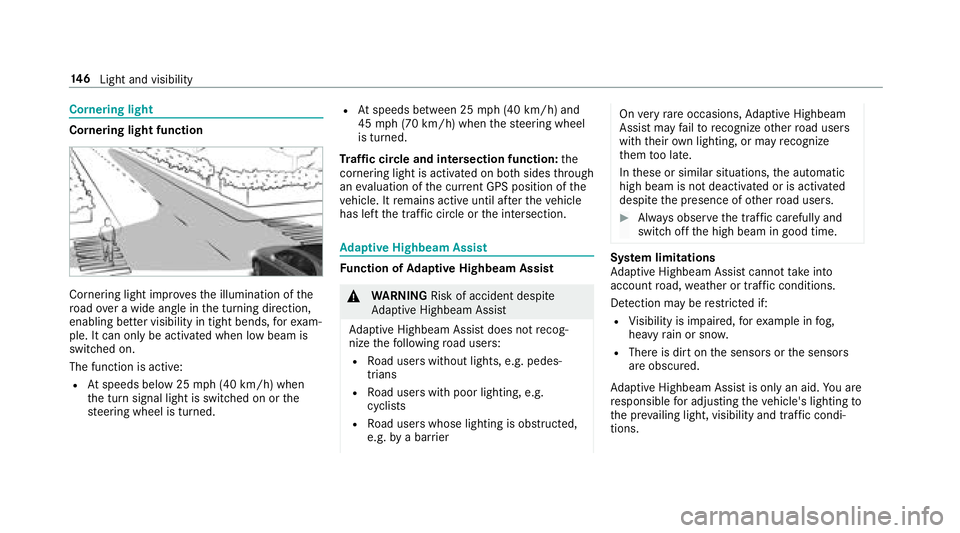
Cornering light
Cornering light function
Cornering light improvesth e illumination of the
ro ad ove r a wide angle in the turning direction,
enabling better visibility in tight bends, forex am‐
ple. It can only be activated when low beam is
switch ed on.
The function is active:
RAt speeds below 25 mph (40 km/h) when
th e turn signal light is switched on or the
st eering wheel is turned.
RAt speeds between 25 mph (40 km/h) and
45 mph (70 km/h) when thesteering wheel
is turned.
Tr af fic circle and intersection function: the
cornering light is acti vated on bo thsides thro ugh
an evaluation of the cur rent GPS position of the
ve hicle. It remains active until af terth eve hicle
has left the traf fic circle or the intersection.
Ad aptive Highbeam Assist
Function of Adaptive Highbeam Assist
&
WARNING Risk of accident despite
Ad aptive Highbeam Assist
Ad aptive Highbeam Assist does not recog‐
nize thefo llowing road users:
RRo ad users without lights, e.g. pedes‐
trians
RRo ad users with poor lighting, e.g.
cyclists
RRo ad users whose lighting is obstructed,
e.g. bya bar rier
On very rare occasions, Adaptive Highbeam
Assist may failto recognize other road users
with their own lighting, or may recognize
th em too late.
In these or similar situations, the automatic
high beam is not deactivated or is activated
despite the presence of other road users.
#Alw ays obser vethe tra ffic carefully and
switch off the high beam in good time.
Sy stem limitations
Ad aptive Highbeam Assist cannot take into
account road, weather or traf fic conditions.
De tection may be restricted if:
RVi sibility is impaired, forex ample in fog,
heavy rain or sno w.
RThere is dirt on the sensors or the sensors
are obscured.
Ad aptive Highbeam Assist is only an aid.You are
re sponsible for adju sting theve hicle's lighting to
th e pr evailing light, visibility and traf fic condi‐
tions.
14 6
Light and visibility
Page 152 of 562
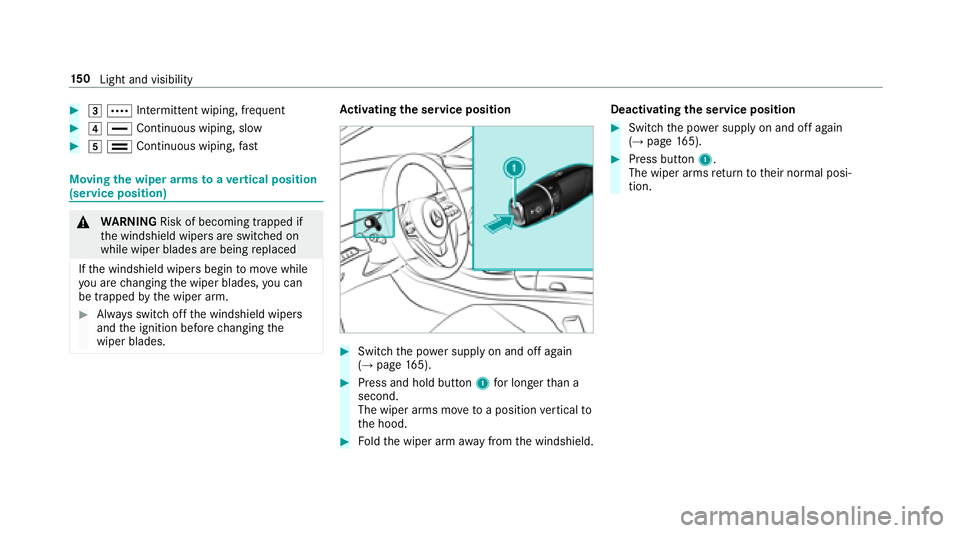
#3Å Intermittent wiping, frequent
#4° Continuous wiping, slow
#5¯ Continuous wiping, fast
Movingthe wiper arms toave rtical position
(service position)
& WARNING Risk of becoming trapped if
th e windshield wipers are switched on
while wiper blades are being replaced
If th e windshield wipers begin tomo vewhile
yo u are changing the wiper blades, you can
be trapped bythe wiper arm.
#Alw ays switch off the windshield wipers
and the ignition before changing the
wiper blades.
Ac tivating the se rvice position
#Swit chthe po wer supp lyon and off again
(→page 165).
#Press and hold button 1for longer than a
second.
The wiper arms mo vetoa position vertical to
th e hood.
#Fo ldthe wiper arm away from the windshield. Deactivating the service position
#Switch
the po wer supp lyon and off again
(→page 165).
#Press button 1.
The wiper arms return totheir normal posi‐
tion.
15 0
Light and visibility
Page 154 of 562
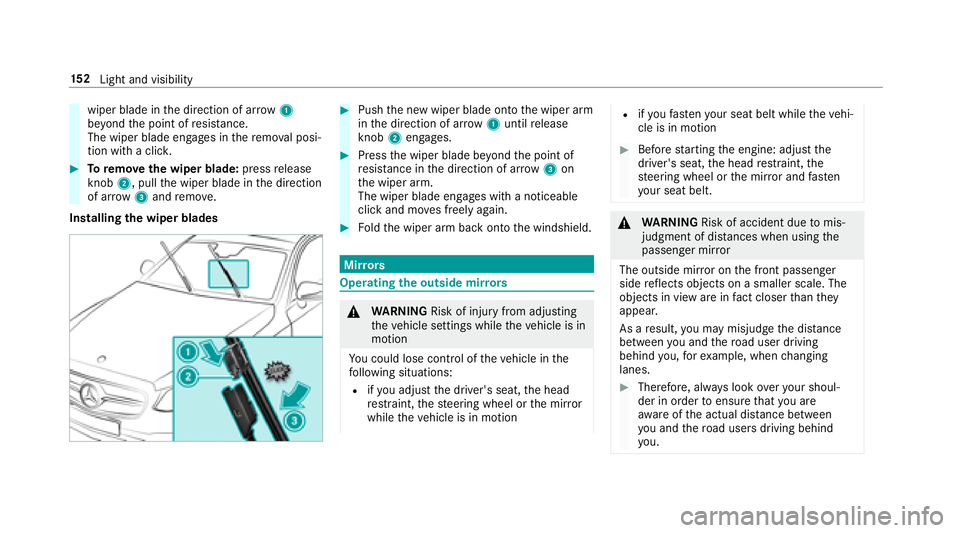
wiper blade inthe direction of ar row1
be yond the point of resis tance.
The wiper blade engages in there mo val posi‐
tion with a clic k.
#Toremo vethe wiper blade: pressrelease
knob 2, pull the wiper blade in the direction
of ar row3and remo ve.
Installing the wiper blades
#Push the new wiper blade onto the wiper arm
in the direction of ar row1untilre lease
knob 2engages.
#Press the wiper blade be yond the point of
re sis tance in the direction of ar row3on
th e wiper arm.
The wiper blade engages with a noticeable
click and mo ves freely again.
#Fo ldthe wiper arm back onto the windshield.
Mir rors
Operating the outside mir rors
&
WARNING Risk of injury from adjusting
th eve hicle settings while theve hicle is in
motion
Yo u could lose cont rol of theve hicle in the
fo llowing situations:
Rifyo u adjust the driver's seat, the head
re stra int, thesteering wheel or the mir ror
while theve hicle is in motion
Rifyo ufa sten your seat belt while theve hi‐
cle is in motion
#Before starting the engine: adjust the
driver's seat, the head restra int, the
st eering wheel or the mir ror and fasten
yo ur seat belt.
&
WARNING Risk of accident due tomis‐
judgment of dis tances when using the
passenger mir ror
The outside mir ror on the front passenger
side reflects objects on a smaller scale. The
objects in view are in fact closer than they
appear.
As a result, you may mis judgethe dis tance
between you and thero ad user driving
behind you, forex ample, when changing
lanes.
#Therefore, alw ays look over your shoul‐
der in order toensure that you are
aw are of the actual dis tance between
yo u and thero ad users driving behind
yo u.
15 2
Light and visibility
Page 155 of 562

Folding the outside mir rors in/out
#Brief lypress switch 1.
% Ifth e battery has been disconnected or com‐
ple tely discharged ,th e outside mir rors must
be reset. Only then will the automatic mir ror
fo lding function workproperly. Ad
justing the outside mir rors
#Select there qu ired mir ror using button 3or
4.
#Use button 2toset the position of the mir‐
ro ryo u ha veselected.
Engaging the outside mir rors
#Press and hold button 1.
Yo uwill hear a click and the mir ror audibly
engage in position. The mir ror is set in the
cor rect position.
In fo rm ation on automatic anti-glare mir rors
&
WARNING Risk of burn s and poisoning
due tothe anti- glare mir ror electrolyte
Electrolyte may escape if theglass in an
automatic anti-glare mir ror breaks.
The electrolyte is harmful and causes ir rita ‐
tion. It must not come into contact wi thyour
skin, eyes,respiratory organs or clo thing or
be swallo wed.
#Ifyo u come into contact with electro‐
ly te , obser vethefo llowing:
RRinse the electrolyte from your skin
and seek medical attention immedi‐
atel y.
RIf electrolyte comes into contact
with your eyes, rinse them thor‐
oughly with clean water and seek
medical attention immediately.
RIf th e electrolyte is swallo wed,
immediately rinse your mouth out
th oroughly. Do not induce vomiting.
Seek medical attention immediately.
RImmediate lych ange out of clo thing
which has come into con tact wi th
electrolyte.
RIf an allergic reaction occurs, seek
medical attention immediatel y.
The outside mirrors and inside rearview mir rors
on the driver's side automatically go into anti-
gl are mode if light from a headlamp hits the
inside rearview mir ror.
Light and visibility 15
3
Page 169 of 562
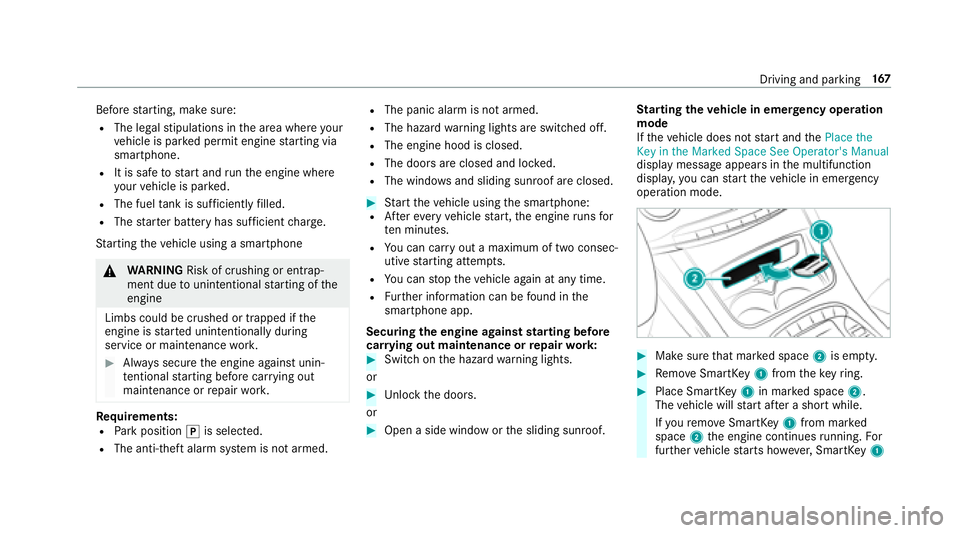
Beforestarting, make sure:
RThe legal stipulations in the area where your
ve hicle is par ked permit engine starting via
smartphone.
RIt is safe tostart and runth e engine where
yo ur vehicle is par ked.
RThe fuel tank is suff icientlyfilled.
RThe star ter battery has suf ficient charge .
St arting theve hicle using a smartphone
&
WARNING Risk of crushing or entrap‐
ment due tounin tentional starting of the
engine
Limbs could be crushed or trapped if the
engine is star ted unintentionally during
service or maintenance work.
#Alw ays secure the engine against unin‐
te ntional starting before car rying out
maintenance or repair work.
Re quirements:RPark position jis selected.
RThe anti- theft alarm sy stem is not armed.
RThe panic alarm is not armed.
RThe hazard warning lights are switched off.
RThe engine hood is closed.
RThe doors are closed and loc ked.
RThe windo wsand sliding sunro of are closed.
#Start theve hicle using the smartphone:RAf tereve ryvehicle start, the engine runs for
te n minu tes.
RYo u can car ryout a maximum of two consec‐
utive starting attem pts.
RYo u can stop theve hicle again at any time.
RFu rther information can be found in the
smartphone app.
Securing the engine against starting before
car rying out maintenance or repair work:
#Switch on the hazard warning lights.
or
#Un lock the doors.
or
#Open a side window or the sliding sunroof. St
arting theve hicle in emer gency operation
mode
If th eve hicle does not start and the�3�O�D�F�H �W�K�H
�.�H�\ �L�Q �W�K�H �0�D�U�N�H�G �6�S�D�F�H �6�H�H �2�S�H�U�D�W�R�U�
�V �0�D�Q�X�D�O
display message appears in the multifunction
displa y,yo u can start theve hicle in emer gency
operation mode.
#Make surethat mar ked space 2is em pty.
#Re mo veSmartK ey1 from theke yring.
#Place Smart Key1 in mar ked space 2.
The vehicle will start af ter a short while.
If yo ure mo veSmartK ey1 from mar ked
space 2the engine continues running. For
fur ther vehicle starts ho wever,SmartK ey1
Driving and pa rking 16
7
Page 172 of 562
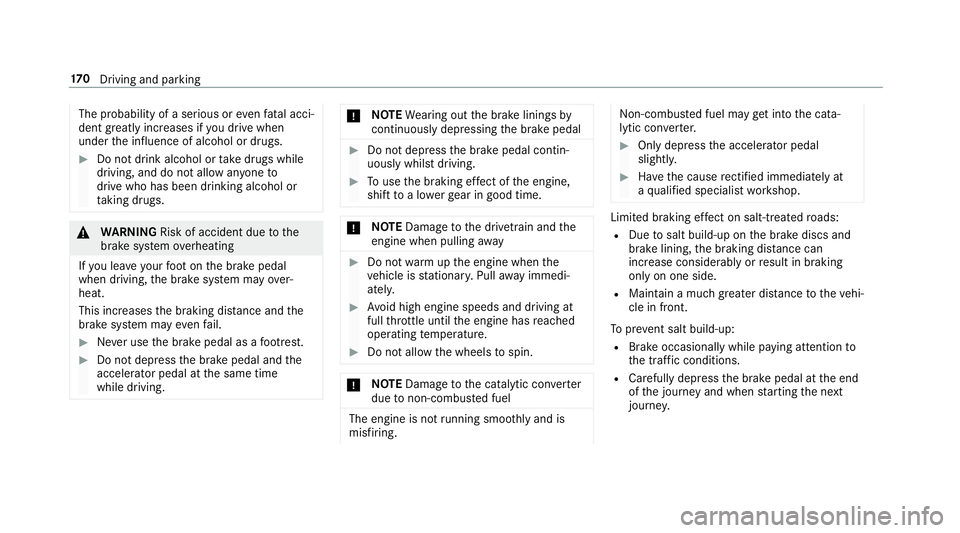
The probability of a serious oreven fata l acci‐
dent greatly inc reases if youdriv e when
under the influence of alcohol or drugs.
#Do not drink alcohol or take drugs while
driving, and do not allow an yone to
drive who has been drinking alcohol or
ta king drugs.
&
WARNING Risk of accident due tothe
brake sy stem overheating
If yo u lea veyour foot on the brake pedal
when driving, the brake sy stem may over‐
heat.
This increases the braking dis tance and the
brake sy stem may evenfa il.
#Ne ver use the brake pedal as a foot re st.
#Do not depress the brake pedal and the
accelerator pedal at the same time
while driving.
* NO
TEWearing out the brake linings by
continuously dep ressing the brake pedal
#Do not depress the brake pedal contin‐
uously whilst driving.
#To use the braking ef fect of the engine,
shift toa lo werge ar in good time.
* NO
TEDama getothe driv etra in and the
engine when pulling away
#Do not warm upthe engine when the
ve hicle is stationar y.Pull away immedi‐
atel y.
#Avoid high engine speeds and driving at
full thro ttle until the engine has reached
operating temp erature.
#Do not allow the wheels tospin.
* NO
TEDama getothe catalytic con verter
due tonon-combu sted fuel
The engine is not running smoot hly and is
misfiring.
Non-combus ted fuel may get into the cata‐
lytic con verter.
#Only depress the accelera tor pedal
slightl y.
#Have the cause rectified immediately at
a qu alified specialist workshop.
Limited braking ef fect on salt-treate dro ads:
RDue tosalt build-up on the brake discs and
brake lining, the braking dis tance can
increase conside rably or result in braking
only on one side.
RMaintain a much greater dis tance totheve hi‐
cle in front.
To preve nt salt build-up:
RBrake occasionally while paying attention to
th e tra ffic conditions.
RCarefully depress the brake pedal at the end
of the journey and when starting the next
journe y.
170
Driving and pa rking